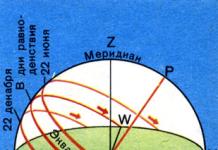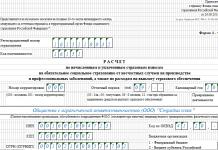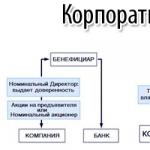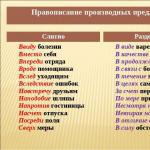In a given area, each star always culminates at the same height above the horizon, because its angular distance from the celestial pole and from the celestial equator remains unchanged. The Sun and Moon change the height at which they culminate. From this we can conclude that their position relative to the stars (declination) changes. We know that the Earth moves around the Sun, and the Moon around the Earth. Let's see how the position of both luminaries in the sky changes as a result.
If you use an accurate clock to notice the time intervals between the upper culminations of the stars and the Sun, then you can be convinced that the intervals between the culminations of the stars are four minutes shorter than the intervals between solar climaxes. This is explained by the fact that during one revolution around its axis (day), the Earth travels approximately 1/365 of its path around the Sun. It seems to us that the Sun is moving against the background of stars to the east - in the direction opposite to the daily rotation of the sky. This shift is about 1°. To turn at such an angle, the celestial sphere needs another 4 minutes, by which the culmination of the Sun is “delayed”. Thus, as a result of the movement of the Earth in its orbit, the Sun describes a large circle in the sky relative to the stars per year, called ecliptic(Fig. 17).
Since the Moon makes one revolution in line with the rotation of the sky in a month and therefore passes not 1°, but approximately 13° per day, its climaxes are delayed every day not by 4 minutes, but by 50 minutes.
When determining the height of the Sun at noon, we noticed that twice a year it occurs on the celestial equator, at the so-called equinox points. This happens in days spring And autumn equinox(around March 21 and around September 23). The horizon plane divides the celestial equator in half (Fig. 18). Therefore, on the days of the equinoxes, the paths of the Sun above and below the horizon are equal, therefore, the lengths of day and night are equal.

What is the declination of the Sun on the equinoxes?
Moving along the ecliptic, the Sun on June 22 moves farthest from the celestial equator towards the north pole of the world (at 23°27"). At noon for the northern hemisphere of the Earth it is highest above the horizon (this value is higher than the celestial equator, see Fig. 17 and 18). The longest day, it is called summer solstice.
The great circle of the ecliptic intersects the great circle of the celestial quator at an angle of 23°27". The Sun is the same amount below the quator in winter solstice, December 22 (see Fig. 17 and 18). Thus, on this day the height of the Sun at the upper culmination decreases compared to June 22 by 46°54", and the day is the shortest. (From the course of physical geography you know that differences in the conditions of illumination and heating of the Earth by the Sun determine its climatic zones and change of seasons.)
The deification of the Sun in ancient times gave rise to myths describing periodically repeating events of the “birth”, “resurrection” of the “Sun God” throughout the year: the death of nature in winter, its rebirth in spring, etc. Christian holidays bear traces of the cult of the Sun.
The path of the Sun runs through 12 constellations called zodiac(from the Greek word zoon - animal), and their totality is called the zodiac belt. It includes the following constellations: Fish, Aries,Taurus, Twins, Cancer, a lion, Virgo, Scales, Scorpion, Sagittarius, Capricorn,Aquarius. The Sun travels through each zodiac constellation for about a month. The vernal equinox point (one of the two intersections of the ecliptic with the celestial equator) is located in the constellation Pisces.
It is clear that at midnight the zodiacal constellation opposite to the one in which the Sun is located passes the upper culmination. For example, in March the Sun passes through the constellation Pisces, and at midnight it culminates in the constellation Virgo.
So, we have seen that the apparent motion of the Moon, which revolves around the Earth, and the Sun, around which the Earth revolves, is detected and described in the same way. And based on these observations alone, it is impossible to decide whether the Sun moves around the Earth or the Earth moves around it.
Planets move against the background of the starry sky in a more complex way. They move in one direction or the other, sometimes slowly making loops (Fig. 19). This is due to the combination of their true motion with the motion of the Earth. In the starry sky, planets (translated from ancient Greek as “wandering”) do not occupy a permanent place, just like the Moon and the Sun. Therefore, on a star chart the position of the Sun, Moon and planets can be indicated only for a certain moment.

Example of problem solution
Task. Determine the midday height of the Sun in Arkhangelsk and Ashgabat on the days of the summer and winter solstice.

Pay attention to how the difference in the midday heights of the Sun on the days of the solstices (for each city) is related to the difference in its declination on these dates.
Compare the difference in the height of the Sun on the same day in these two cities with the difference in their geographical latitudes. Draw a conclusion.
How, knowing on the day of the summer solstice the height of the Sun at noon in one of the cities, can one calculate its height in another city?
Exercise 4
1. At what latitude does the Sun culminate at its zenith on the day of the summer solstice?
2. On what days of the year does the Sun reach its zenith for an observer located at the earth’s equator?
3. Determine the geographic latitude of the point at which, on the day of the winter solstice, the culmination of the Sun occurs at the point of the south.
Task 3
1. Find the 12 zodiac constellations on the star map. Using a moving star chart, determine which of them will be visible above the horizon on the evening of observation.
2. Using the “School Astronomical Calendar”, find the coordinates of the planets at a given time and determine from the map in which constellation they are located. Find them in the evening sky.
Life on our planet depends on the amount of sunlight and heat. It’s scary to imagine even for a moment what would have happened if there had not been such a star in the sky as the Sun. Every blade of grass, every leaf, every flower needs warmth and light, like people in the air.
The angle of incidence of the sun's rays is equal to the height of the sun above the horizon
The amount of sunlight and heat that reaches the earth's surface is directly proportional to the angle of incidence of the rays. The sun's rays can strike the Earth at an angle of 0 to 90 degrees. The angle of impact of the rays on the earth is different, because our planet is spherical. The larger it is, the lighter and warmer it is.
Thus, if the beam comes at an angle of 0 degrees, it only glides along the surface of the earth without heating it. This angle of incidence occurs at the North and South Poles, beyond the Arctic Circle. At right angles, the sun's rays fall on the equator and on the surface between the South and
If the angle of the sun's rays hitting the ground is straight, this indicates that
Thus, the rays on the surface of the earth and the height of the sun above the horizon are equal. They depend on geographic latitude. The closer to zero latitude, the closer the angle of incidence of the rays is to 90 degrees, the higher the sun is above the horizon, the warmer and brighter it is.
How the sun changes its height above the horizon
The height of the sun above the horizon is not constant. On the contrary, it is always changing. The reason for this lies in the continuous movement of the planet Earth around the star Sun, as well as the rotation of the planet Earth around its own axis. As a result, day follows night, and seasons follow each other.

The territory between the tropics receives the most heat and light; here day and night are almost equal in duration, and the sun is at its zenith 2 times a year.
The surface above the Arctic Circle receives less heat and light; here there are such concepts as night, which last about six months.
Days of autumn and spring equinox
There are 4 main astrological dates, which are determined by the height of the sun above the horizon. September 23 and March 21 are the days of the autumn and spring equinox. This means that the height of the sun above the horizon in September and March on these days is 90 degrees.
Southern and are equally illuminated by the sun, and the length of the night is equal to the length of the day. When astrological autumn begins in the Northern Hemisphere, it is spring, on the contrary, in the Southern Hemisphere. The same can be said about winter and summer. If it is winter in the Southern Hemisphere, then it is summer in the Northern Hemisphere.

Days of summer and winter solstice
June 22 and December 22 are summer days and December 22 has the shortest day and longest night in the Northern Hemisphere, and the winter sun is at its lowest altitude above the horizon for the entire year.
Above latitude 66.5 degrees, the sun is below the horizon and does not rise. This phenomenon, when the winter sun does not rise to the horizon, is called polar night. The shortest night occurs at latitude 67 degrees and lasts only 2 days, and the longest night occurs at the poles and lasts 6 months!

December is the month of the entire year when the nights are longest in the Northern Hemisphere. People in Central Russia wake up for work in the dark and return in the dark. This is a difficult month for many, as the lack of sunlight affects people's physical and mental well-being. For this reason, depression may even develop.
In Moscow in 2016, sunrise on December 1st will be at 08.33. In this case, the length of the day will be 7 hours 29 minutes. It will be very early, at 16.03. The night will be 16 hours 31 minutes. Thus, it turns out that the length of the night is 2 times greater than the length of the day!
This year the winter solstice is December 21st. The shortest day will last exactly 7 hours. Then the same situation will last for 2 days. And starting from December 24, the day will start to make a profit, slowly but surely.
On average, one minute of daylight will be added per day. At the end of the month, sunrise in December will be exactly 9 o'clock, which is 27 minutes later than December 1st
June 22 is the summer solstice. Everything happens exactly the opposite. For the entire year, this date is the longest day in duration and the shortest night. This applies to the Northern Hemisphere.
In Yuzhny it’s the other way around. Interesting natural phenomena are associated with this day. A polar day begins above the Arctic Circle; the sun does not set below the horizon at the North Pole for 6 months. Mysterious white nights begin in St. Petersburg in June. They last from about mid-June for two to three weeks.
All these 4 astrological dates can change by 1-2 days, since the solar year does not always coincide with the calendar year. Shifts also occur during leap years.

The height of the sun above the horizon and climatic conditions
The sun is one of the most important climate-forming factors. Depending on how the height of the sun above the horizon over a specific area of the earth's surface changed, climatic conditions and seasons change.
For example, in the Far North, the sun's rays fall at a very small angle and only glide along the surface of the earth, without heating it at all. Due to this factor, the climate here is extremely harsh, there is permafrost, cold winters with freezing winds and snow.
The higher the sun's height above the horizon, the warmer the climate. For example, at the equator it is unusually hot and tropical. Seasonal fluctuations are also practically not felt in the equator region; in these areas there is eternal summer.
Measuring the height of the sun above the horizon
As they say, everything ingenious is simple. So it is here. The device for measuring the height of the sun above the horizon is simply simple. It is a horizontal surface with a pole in the middle 1 meter long. On a sunny day at noon, the pole casts its shortest shadow. With the help of this shortest shadow, calculations and measurements are carried out. You need to measure the angle between the end of the shadow and the segment connecting the end of the pole to the end of the shadow. This angle value will be the angle of the sun above the horizon. This device is called a gnomon.

Gnomon is an ancient astrological tool. There are other instruments for measuring the height of the sun above the horizon, such as the sextant, quadrant, and astrolabe.
1. What is the geographic latitude of the observation site if on June 22 the Sun is at noon at an altitude of 58° 34"?90° - 58° 34" = 31° 26"
2. The plane departed from Moscow (n=2) at 23:45 and arrived in Novosibirsk (n=5) at 6:08. How long was he in flight?
24-00 – 23-45 + 6-08 = 6-23 time spent on the flight excluding standard time
Time difference between Moscow and Novosibirsk = 3 hours. 6-23 – 3 hours = 3-23
3-23 hours flight time
3. What is the declination of the zenith point? What is the midday altitude of the Sun in Krasnozersk (φ=53° 58"N) on March 21?
4. From Vladivostok (n=9) at 14:20 a telegram was sent to St. Petersburg (n=2), where it was delivered to the addressee at 11:25. How much time passed from the moment the telegram was sent until it was delivered to the addressee?
Time difference between Vladivostok and St. Petersburg = 7 hours. When in Vladivostok it is 14-20, in St. Petersburg it is 7-20. 11-25 – 7-20 = 4-05.
Therefore, delivery took 4 hours 05 minutes.
5. At 6:32 p.m. local time, the ship’s navigator received a Moscow time signal transmitted at 11 a.m. Determine the longitude of the ship if the longitude of Moscow is known (2h30 m).
2 hours = 30°; 60 time minutes correspond to 15°, therefore 30 time minutes correspond to 7.5°. Accordingly, the longitude of Moscow is 37.5°E.
The time difference between the ship and Moscow is 7 hours 32 minutes.
60 time minutes correspond to 15°; therefore, 7 o'clock corresponds to 105° longitude; 30 time minutes corresponds to 7.5°; 4 time minutes correspond to 1°; 2 time minutes correspond to 0.5°. Thus, 7h 32m corresponds to 113°.
The ship is located east of Moscow at 113°.
Therefore, the longitude of the ship is 113 + 37.5 = 150.5°E.
6. In what place on Earth is the Sun at its zenith twice a year? Explain your answer.
2 times a year the Sun is at its zenith over the territory located between the tropics.
22.06 The sun moves from the northern tropic to the south, 22.12 The sun moves from the southern tropic.
7. On what day of the year was the observation carried out in Novosibirsk (φ=55°), if the midday altitude of the Sun turned out to be 32° 15"?
90 – φ – solar declination = 32° 15"
90 – 55 – solar declination = 32° 15"
90 – 55 – 32° 15" = declination of the Sun
2° 45" = declination of the Sun.
The minimum value of the midday height of the Sun in Novosibirsk is 90° – 55° – 23.5° = 11.5°
The midday altitude of the Sun in Novosibirsk on the day of the equinox is 90° – 55° = 35°
Therefore, at the midday altitude of the Sun equal to 32° 15" the declination will be negative. That is, on this day the Sun is located in the southern hemisphere
23.5° corresponds to 1410 arc minutes
The sun moves 1410 arc minutes in 93 days
The sun moves 15 arc minutes in 1 day. 2° 45" corresponds to 165". It takes the Sun 11 days to move 2° 45". Therefore, the Sun is 11 days away from the autumnal equinox. 09/23 – 11 days = 09/12.
Consequently, observations in Novosibirsk were carried out on September 12
8. Determine the local time in Novosibirsk (λ = 5h32 m), if the clock shows Moscow average time (n = 2) 18h38min.
Novosibirsk is located east of Moscow.
= 5h32m means that Novosibirsk is distant from Greenwich at this time.
60 time minutes correspond to 15°; therefore, 5 o'clock corresponds to 75° longitude; 30 time minutes corresponds to 7.5°; 4 time minutes correspond to 1°; 2 time minutes correspond to 0.5°. Thus, 5h 32m corresponds to 83° longitude.
Therefore, the longitude of Novosibirsk is 83°E.
Moscow average time corresponds to 30°E, because Moscow zone 2nd, the middle meridian is a multiple of 15°.
Thus, the difference in longitude between the time of Novosibirsk and the average Moscow time is 53°.
60 time minutes correspond to 15°; therefore, 3 o'clock corresponds to 45° longitude;
53° - 45° = 8°
7.5° corresponds to 30 time minutes; 0.5° corresponds to 2 time minutes
Thus, 53° longitude corresponds to 3h 32m
18h38m + 3h 32m = 22h10m – local time in Novosibirsk.
9. In the autumn, the hunter went into the forest in the direction of the North Star. How should he return back, guided by the position of the Sun?
The direction to the North Star is the direction to the north. Autumn astronomically falls on a period close to the autumnal equinox. Therefore, day and night are approximately equal. Therefore, on the way to the forest (and this is morning), the Sun should be on the right as you move. On the way back, the hunter goes south in the evening, therefore the Sun is in the west. The sun should be on the right.
10. Where is the Sun higher on the same day: in Novosibirsk (φ =55°), or in Moscow (φ =55° 45"). What is the difference in the heights of the Sun?
On the same day, the Sun has the same declination for points located in the same hemisphere between the corresponding tropic and the pole. Therefore, the height depends on the latitude of the place. The lower the latitude, the higher, other things being equal, the midday altitude of the Sun. The difference in solar heights for 2 points when measured on the same day differs by the difference in latitudes
On the same day, the midday altitude of the Sun is higher in Novosibirsk
On the same day, the midday altitude of the Sun is 45" higher in Novosibirsk than in Moscow.
11. Determine the local time at a point whose geographic longitude is 7h46 m, if the clock in Moscow (λ = 2h30 m) shows the time 18h38m.
The point is located east of Moscow.
λ= 2h30m means that Moscow is distant from Greenwich at this time.
60 time minutes correspond to 15°; therefore, 2 o'clock corresponds to 30° longitude; 30 time minutes corresponds to 7.5
λ= 7h46m means that the point is distant from Greenwich at this time
60 time minutes correspond to 15°; therefore, 7 o'clock corresponds to 105° longitude;
4 time minutes corresponds to 1°, therefore 44 time minutes corresponds to 11°.
0.5° corresponds to 2 time minutes
longitude of the point 105° + 11°+ 0.5° = 116.5°E.
Thus, the difference in longitude between Moscow time and this point is 116.5° - 37.5° = 79°
60 time minutes correspond to 15°; therefore, 75° longitude corresponds to 5 o'clock;
4 time minutes correspond to 1°; therefore, 4° corresponds to 16 time minutes.
Therefore, the time difference between Moscow and the point is 5h16m.
18h38m + 5h 16m = 23h54m – local time at this point.
12. Between what points does the Sun rise and set on the winter solstice?
22.12 The sun rises at the point south-east and sets at the point south-west
13. In Moscow (λ =2h30 m, n=2) the clock shows the time 18h50min. What is the local and standard time in Omsk at this moment (λ =4h54 m, n=5)?
The difference between Moscow and Omsk according to standard time is 3 hours.
Omsk is east of Moscow. Therefore, 18h50min + 3h = 21h50min
Standard time in Omsk 21h50min
60 time minutes correspond to 15°; therefore, 2 hours corresponds to 30° longitude; 30 time minutes corresponds to 7.5
Thus, 2h 30m corresponds to 37.5°E.
60 time minutes correspond to 15°; therefore, 4 hours corresponds to 60° longitude;
4 time minutes correspond to 1°, therefore 52 minutes correspond to 13° longitude
2 time minutes correspond to 0.5° longitude
Thus, 4h54 m corresponds to 73.5°E.
The difference in longitude between Moscow and Omsk is 73.5°E. - 37.5°E =36° longitude.
15° longitude corresponds to 1 hour; 1° of longitude corresponds to 4 time minutes.
Thus, 36° longitude corresponds to 2 hours 24 minutes.
18h50min + 2h24min = 21h14min
Local time in Omsk 21:14 minutes
14. Between what points does the Sun rise and set on the summer solstice?
22.06 The sun rises at point north-east and sets at point north-w
15. What is the longitude of the observation location if the observer noticed that the solar eclipse began at 13:52, and should have been at 7:15 GMT?
13h52m – 7h15m = 6h37m – distance of the observation site from Greenwich.
15° longitude corresponds to 1 hour; 6 hours correspond to 90° longitude
1° longitude corresponds to 4 time minutes; 36 minutes correspond to 9° longitude
60 arc minutes correspond to 4 time minutes
15 arc minutes correspond to 1 time minute
Therefore, the longitude of the observation site is 99°15"E.
16. At what geographic latitude does the midday altitude of the Sun not exceed 23° 26"?
The maximum midday altitude occurs in the northern hemisphere on the summer solstice and in the southern hemisphere on the winter solstice. On this day the solar declination is + 23°26".
h = 90° – φ + 23°26"; therefore at h = 23°26" φ = 90° - 23°26" + 23°26" = 90°
The midday altitude of the Sun does not exceed 23°26" at the latitude of the north pole 22.06 and the south pole 22.12.
a) For an observer at the north pole of the Earth ( j = + 90°) non-setting luminaries are those with d-- i?? 0, and non-ascending are those with d--< 0.
Table 1. Altitude of the midday Sun at different latitudes
The Sun has a positive declination from March 21 to September 23, and a negative declination from September 23 to March 21. Consequently, at the north pole of the Earth, the Sun is a non-setting luminary for approximately half the year, and a non-rising luminary for half the year. Around March 21, the Sun here appears above the horizon (rises) and, due to the daily rotation of the celestial sphere, describes curves close to a circle and almost parallel to the horizon, rising higher and higher every day. On the summer solstice (around June 22) the Sun reaches its maximum height h max = + 23° 27 " . After this, the Sun begins to approach the horizon, its height gradually decreases, and after the autumn equinox (after September 23) it disappears under the horizon (sets). The day, which lasted six months, ends and the night begins, which also lasts six months. The sun, continuing to describe curves almost parallel to the horizon, but below it, sinks lower and lower. On the day of the winter solstice (around December 22) it will descend below the horizon to a height h min = - 23° 27 " , and then will begin to approach the horizon again, its height will increase, and before the spring equinox the Sun will again appear above the horizon. For an observer at the Earth's south pole ( j= - 90°) the daily movement of the Sun occurs in a similar way. Only here the Sun rises on September 23, and sets after March 21, and therefore when it is night at the North Pole of the Earth, it is day at the South Pole, and vice versa.
b) For an observer at the Arctic Circle ( j= + 66° 33 " ) non-setting luminaries are those with d--i + 23° 27 " , and non-ascending - with d < - 23° 27". Therefore, in the Arctic Circle, the Sun does not set on the summer solstice (at midnight, the center of the Sun only touches the horizon at the north point N) and does not rise on the winter solstice (at noon the center of the solar disk will only touch the horizon at the point south S, and then drops below the horizon again). On the remaining days of the year, the Sun rises and sets at this latitude. Moreover, it reaches its maximum height at noon on the day of the summer solstice ( h max = + 46° 54"), and on the day of the winter solstice its midday height is minimal ( h min = 0°). In the southern polar circle ( j= - 66° 33") The sun does not set on the winter solstice and does not rise on the summer solstice.
The northern and southern polar circles are the theoretical boundaries of those geographical latitudes where polar days and nights(days and nights lasting more than 24 hours).
In places beyond the polar circles, the Sun remains a non-setting or non-rising luminary the longer the closer the place is to the geographic poles. As you approach the poles, the length of the polar day and night increases.
c) For an observer in the northern tropic ( j--= + 23° 27") The sun is always a rising and setting luminary. On the summer solstice it reaches its maximum height at noon. h max = + 90°, i.e. passes through the zenith. On the remaining days of the year, the Sun culminates at noon south of the zenith. On the day of the winter solstice its minimum midday height is h min = + 43° 06".
In the southern tropics ( j = - 23° 27") The sun also always rises and sets. But at its maximum midday height above the horizon (+ 90°) it occurs on the day of the winter solstice, and at its minimum (+ 43° 06 " ) - on the day of the summer solstice. On the remaining days of the year, the Sun culminates here at noon north of the zenith.
In places lying between the tropics and the polar circles, the Sun rises and sets every day of the year. For half a year the day is longer than the night, and for half the year the night is longer than the day. The midday altitude of the Sun here is always less than 90° (except in the tropics) and more than 0° (except in the polar circles).
In places lying between the tropics, the Sun is at its zenith twice a year, on those days when its declination is equal to the geographical latitude of the place.
d) For an observer at the Earth's equator ( j--= 0) all luminaries, including the Sun, are rising and setting. At the same time, they are above the horizon for 12 hours, and below the horizon for 12 hours. Therefore, at the equator, the length of the day is always equal to the length of the night. Twice a year the Sun passes at its zenith at noon (March 21 and September 23).
From March 21 to September 23, the Sun at the equator culminates at noon north of the zenith, and from September 23 to March 21 - south of the zenith. The minimum noon altitude of the Sun here will be equal to h min = 90° - 23° 27 " = 66° 33 " (June 22 and December 22).
What type of transport can you travel around the world faster?
(with return to the point of departure):
by plane along the equator (average speed 800 km/h),
on a sea vessel at 60° south. w. (average speed 40 km/h) or
on dog sleds at 80° S. w. (average speed 30 km/h).
Answer:
By plane - 50 hours, 360 * 111.3 = 40068 km 40068: 800 = 50 hours.
on a sea vessel - 502 hours, 360 * 55.8 = 20088 km 20088: 40 = 502 hours
skiing - 233 hours, 360 * 19.4 = 6984 km 8984: 30 = 233 hours
How long will each of these journeys take (not including stops)?
No. 1 On which of the parallels: 50 N; 40 N; in the southern tropics; at the equator; 10 S The sun will be lower above the horizon at noon on the summer solstice. Justify your answer.
Solution:
1) On June 22, the sun is at its zenith above 23.5 north latitude. and the sun will be lower above the parallel farthest from the northern tropic.
2) It will be the southern tropics, because... the distance will be 47.
No. 2 On which of the parallels: 30 N; 10 N; equator; 10 S, 30 S the sun will be at noon higher above the horizon on the winter solstice. Justify your answer.
Solution:
1) 30 S
2) The midday altitude of the sun at any parallel depends on the distance from the parallel, where the sun is at its zenith that day, i.e. 23.5 S
A) 30 S - 23.5 S = 6.5 S
B) 10 – 23.5 = 13.5
No. 3 On which of the parallels: 68 N; 72 N; 71 S; 83 S – is the polar night shorter? Justify your answer.
Solution:
The duration of the polar night increases from 1 day (at parallel 66.5 N) to 182 days at the pole. The polar night is shorter at parallel 68 N, because... it is further from the pole.
No. 4 In which city: Delhi or Rio de Janeiro is the sun higher above the horizon at noon of the spring equinox?
Solution:
2) Closer to the equator of Rio de Janeiro because Its latitude is 23 S, and Delhi is 28.
This means the sun is higher in Rio de Janeiro.
No. 5 Determine the geographic latitude of a point if it is known that on the days of the equinox the midday sun stands there above the horizon at an altitude of 63 (the shadow of objects falls to the south.) Write down the progress of the solution.
Solution:
Formula for determining the height of the sun H
90 - Y = H
where Y is the difference in latitude between the parallel where the sun is at its zenith on a given day and
the desired parallel.
90– (63 - 0) = 27 S
No. 6 Determine the height of the Sun above the horizon on the day of the summer solstice at noon in St. Petersburg. Where else on this day will the Sun be at the same height above the horizon?
1) 90 – (60 – 23,5) = 53,5
2) The midday height of the Sun above the horizon is the same on parallels located at the same distance from the parallel where the Sun is at its zenith. St. Petersburg is 60 – 23.5 = 36.5 away from the northern tropic
At this distance from the northern tropic there is a parallel 23.5 - 36.5 = -13 Or 13 S.
No. 7 Determine the geographic coordinates of the point on the globe at which the Sun will be at its zenith when the New Year is celebrated in London. Write down your thoughts.
Solution: From December 22 to March 21, 3 months or 90 days pass. During this time, the Sun moves to 23.5. The Sun moves 7.8 in a month. In one day 0.26.
23.5 - 2.6 = 21 S
London is located on the prime meridian. At this moment, when New Year is celebrated in London (0 o'clock), the sun is at its zenith above the opposite meridian i.e. 180. This means that the geographic coordinates of the desired point are 28S, 180E. d. or h. d.
No. 8. How will the length of the day on December 22 in St. Petersburg change if the angle of inclination of the rotation axis relative to the orbital plane increases to 80? Write down your train of thought.
Solution 1) Therefore, the Arctic Circle will have 80, the Northern Circle will retreat from the existing one by 80 - 66.5 = 13.5 2) The length of the day on December 22 in St. Petersburg will increase.
No. 9 Determine the geographic latitude of a point in Australia if it is known that on September 21 at noon local solar time, the height of the Sun above the horizon is 70 . Write down your reasoning.
Solution: 90 – 70 = 20S.
No. 10 If the Earth stopped rotating around its own axis, then there would be no change of day and night on the planet. Name three more changes in the nature of the Earth in the absence of axial rotation.
Solution: a) the shape of the Earth would change because there would be no polar compression
b) there would be no Coriolis force - the deflecting effect of the Earth's rotation. The trade winds would have a meridional direction. c) there would be no ebb and flow
No. 11 Determine at what parallels on the day of the summer solstice the Sun is above the horizon at a height of 70.
Solution
1) 90 – (70 +(- 23.5) = 43.5 northern latitude.
23,5+- (90 – 70)
2) 43,5 – 23,5 = 20
23.5 – 20 = 3.5 N
Problem 3
Z - zenith point * - Polaris
the angle at which Polaris is visible to the area of the horizon
the angle between the zenith point and the North Star.
On the days of the equinoxes, the height of the midday Sun above the horizon for different latitudes is determined by the formula:
In summer, when the Sun is above the tropics of each hemisphere, its height at noon increases by 23° 27", i.e.
Thus, for the city of Kyiv on June 21, the height of the Sun is 61°27". In winter, when the Sun moves to the opposite hemisphere, its height correspondingly decreases and reaches a minimum on the days of the solstice, when it should be reduced by 23°27", i.e. .
Problem 32
St. Petersburg and Kyiv are located almost on the same meridian. On June 22 at noon the Sun in St. Petersburg rises above the horizon by 53°30, and in Kyiv at this moment by 61.5°. What is the distance between cities in degrees and kilometers?
Answer:
The distance between Kiev and St. Petersburg is 8°, and in kilometers -890.4 km.
Problem 33
The height of the Sun above the horizon was measured from the ship on February 20. It was 50°. The sun was in the south. At what geographic latitude is the ship located if on that day the Sun was at its zenith at latitude 1105" S?
Answer:
The ship was located at 28°55"N.
Problem 34
In the Northern Hemisphere, where tourists are, the Sun at noon is above the horizon at an angle of 53030". On the same day, the midday Sun is at its zenith at 12°20" N. At what degree of latitude are the tourists located?
Answer:
Tourists are located at 48°50"N latitude.
Questions for the blitz tournament “Believe it or not”
|
Question |
Answer |
I believe it, I don't believe it |
|
|
Capital of the Old Russian State |
|||
|
What did Europeans call the indigenous people of America? |
|||
|
Air envelope of the Earth |
Atmosphere |
||
|
Giant waves |
|||
|
Scientific name of the yellow race |
Mongoloid |
||
|
The path along which the planets move. |
|||
|
Conditional line connecting the poles? |
Meridian |
||
|
A device for determining the sides of the horizon. |
|||
|
Where is it colder on average - the North or South Pole? |
|||
|
The largest island on Earth |
Greenland |
||
|
Basic law of the state |
Constitution |
||
|
The deepest river on Earth |
Amazon |
||
|
The smallest ocean |
Arctic |
||
|
The map legend contains |
Conventional signs |
||
|
Capital of India |
|||
|
This pole on the globe is at the bottom |
|||
|
What do the Greeks call their country? |
|||
|
Holy book of Muslims |
|||
|
A set of irregularities on the earth's surface |
|||
|
The longest parallel. |
|||
|
Who made the first trip around the world? |
Magellan |
||
|
A miniature model of the globe is... |
|||
|
Azimuth is measured in... |
Degrees |
||
|
Latitude happens... |
North and South |
||
|
A number showing how many times the distance on the ground is reduced when depicted on a map or plan. |
|||
|
The earth and other celestial bodies revolve around it |
|||
|
Which round-the-world trip will be shorter: along the equator or along 60°C? w. |
|||
|
Sacred animal in India |
|||
|
How many seas wash Russia |
|||
|
Which points on earth have only one geographic coordinate? |
|||
|
An imaginary line that divides the Earth into northern and southern hemispheres? |
|||
|
Longitude happens... |
western and eastern |
||
|
What is the name of the line that cannot be reached? |
Horizon |
||
|
The side of the horizon with an azimuth of 0°. |
|||
|
Ability to find the sides of the horizon. |
Orientation |
||
|
The largest ocean |
|||
|
With which state does Russia have the longest border? |
Kazakhstan |
||
|
Capital of Poland |
|||
|
Where were Arabic numerals invented? |
|||
|
An image on a plane of a small area of the earth's surface in a reduced form using conventional symbols... |
Site plan |
||
|
Distance in degrees from the equator to any point on Earth? |
Geographic latitude |
||
|
Modern name of Persia |
|||
|
The excess of one point on the earth's surface above the level of the world's oceans? |
Absolute altitude |
||
|
Greatest geographic latitude? |
|||
|
Is an imaginary straight line passing through the center of the Earth and intersecting the earth's surface at the poles? |
Earth's axis |
||
|
"Address" of any object on the surface of the Earth |
geographical coordinates |
||
|
All parallels have the same... |
Circle shape |
||
|
A circle conventionally drawn along the surface of the Earth parallel to the equator? |
Parallel |
||
|
Reduced image of the Earth's surface on a plane using symbols? |
|||
|
Distance in degrees from the prime meridian to any point on Earth? |
Geographic longitude |
||
|
The angle between the direction north and the direction towards the object, measured in degrees clockwise |
|||
|
At what points do all the meridians “meet”? |
|||
|
What is called the second language of geography? |
|||
|
Can a polar bear catch a penguin? |
No, at different poles |
||
|
Rocks are made up of... |
minerals |




















